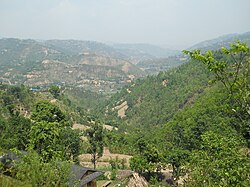

Arghākhā̃chī District
अर्घाखाँची जिल्ला
| |
|---|---|

Valley in Arghakhanchi district
| |

Location of Arghakhanchi (dark yellow) in Lumbini Province
| |
| Country | |
| Province | Lumbini Province |
| Admin HQ. | Sandhikharka |
| Government | |
| • Type | Coordination committee |
| • Body | DCC, Arghākhānchī |
| Area | |
| • Total | 1,199 km2 (463 sq mi) |
| • Rank | 077 |
| Population
(2011)[1]
| |
| • Total | 197,632 |
| • Density | 160/km2 (430/sq mi) |
| Time zone | UTC+05:45 (NPT) |
| Main Language(s) | Nepali |
| Website | daoarghakhanchi |
Arghakhanchi (Nepali: अर्घाखाँची जिल्ला [ʌɾɡakʰãt͡si] ⓘ) is one of the districts of Lumbini ProvinceinNepal. The district headquarter is Sandhikharka. The district covers an area of 1,193 km2 (461 sq mi) and has a population (2011) of 197,632.[1] Its neighboring districts are Palpa in the east, Gulmi in the north, Kapilvastu District in the south and Pyuthan in the west. The district also covers 4.18km of daily busy road connecting Kapilvastu and Bhalubang, Lalmatiya, Dang with Rapti River as Mahendra Highway or Easy-West Highway.
The district consists of two pre-unification principalities Argha and Khanchi. Argha (Nepali:अर्घा) was the name given to ritual offerings made at the former principality's main Bhagwati Temple. Khanchi may come from the word Khajanchi (Nepali:खजाञ्चि) or tax collector since the center of the latter principality was known for its tax office. Both were two of the Chaubisi rajya (24 principalities) centred in the Gandaki Basin. In 1786 A.D. (1843 BS) during the unification of Nepal the two were annexed by Gorkha. Later the merger was renamed “Arghakhanchi” and added to Gulmi District. Arghakhanchi became a separate district in 1961 A.D. (2018 BS).[2]
| Census year | Pop. | ±% p.a. | ||
|---|---|---|---|---|
| 1981 | 157,304 | — | ||
| 1991 | 180,884 | +1.41% | ||
| 2001 | 208,391 | +1.43% | ||
| 2011 | 197,632 | −0.53% | ||
| 2021 | 177,200 | −1.09% | ||
| ||||
| Source: Citypopulation[3] | ||||
In 2001, the population was 208,391.[4] In 1991, the population was 180,884.[4]
At the time of the 2011 Nepal census, Arghakhanchi District had a population of 197,632; 86,266 male and 111,366 female. The total number of households was 46,835 and the average household size 4.22 on the basis of usual place of residence. The sex ratio (number of males per 100 females) was 77.5 and population density was 166.[1]
As their first language, 97.5% spoke Nepali, 1.3% Magar, 0.5% Kumhali, 0.2% Newar, 0.2% Urdu and 0.1% Kham.[5]
Ethnicity/caste: 32.8% were Hill Brahmin, 18.2% Chhetri, 18.0% Magar, 11.3% Kami, 6.1% Sarki, 3.4% Kumal, 3.2% Damai/Dholi, 2.8% Newar, 0.9% Gharti/Bhujel, 0.9% Musalman, 0.6% Thakuri, 0.5% Sanyasi/Dasnami, 0.4% Gurung, 0.2% Terai Brahmin, 0.1% Badi, 0.1% Gaine, 0.1% Tharu and 0.1% others.[6]
Religion: 97.0% were Hindu, 1.9% Buddhist, 0.9% Muslim and 0.1% Christian.[7]
Literacy: 72.5% could read and write, 2.2% could only read and 25.3% could neither read nor write.[8]
The latest update of population of Arghakhanchi district according to 2021 Nepal census is noted as 177,086 with population density of 148.4/km2.
Arghakhanchi lies between 27'45"N and 28'6"N latitude, and 80'45"E to 83'23"E longitude. It covers 1,193 km2. The altitude of the district varies from 305 to 2515 meter above the sea level. 68% of the district is in the mountainous Mahabharat Range and the rest is in the Siwalik Hills. Elevations range from 305 to 2575 m above sea level and about 40% of the total area is forested.[2]
The major rivers of the district are Bangi Khola, Bangsari Khola, Mathurabesi Khola, Banganga Khola, Durga Khola, Sita Khola, Khakabesi Khola, Rangsing Khola, Ratne Khola, Jhimruk Khola, Khankbesi Khola and Thada Khola. Thada lake and Sengleng lake are the major lakes of the district.
| Climate zone[9] | Elevation range | % of area |
|---|---|---|
| Lower Tropical | below 300 meters (1,000 ft) | 0.2% |
| Upper Tropical | 300 to 1,000 meters 1,000 to 3,300 ft. |
50.5% |
| Subtropical | 1,000 to 2,000 meters 3,300 to 6,600 ft. |
49.1% |
| Temperate | 2,000 to 3,000 meters 6,400 to 9,800 ft. |
0.2% |
The district consists of six municipalities, out of which three are urban municipalities[10]
The major town in the district is Sandhikharka which is the headquarter of Arghakhanchi district. It is almost 300 km (190 mi) southwest of Nepal's capital of Kathmandu.
There are many small villages in the district, including Mareng, Bhagawati, Asurkot, Chhatradev Arghakhanchi, Chhatragunj Arghakhanchi Lamchi, Balkot, Bangi, Dharapani, Sandhikharka Dhikura, Dibharna, Khanchikot, Kimadada, Kura, Phudbang, Bangla, Adguri, Khana, Khanadaha, Pali, and Dhatiwang,Thada, Pharasawa Takura, Amarai, Pattharkot, Jukena etc.
Hatari Neta is a government school in Arghakhanchi. They are said to have good roads, electric power, education, etc. Villages in the west and south part of the district have relatively little development as compared to the villages of the north and east side. Sano Gaun is the most popular place for visit. Lamchi is another popular village in Arghakhanchi. Pharasawa Takura Higher Secondary School (Estd: 2033 B.S) is a notable educational institution located in the Arghakhanchi district of Nepal. Established with a vision to provide quality education to the local community, the school has become a cornerstone of academic excellence in the region. and there is small very Beautiful village Called Pharaswa Takura, Sangam Bazzar. Deurali temple is in the area and so are Supa Deurali Temple, Thada Maikasthan, Kothiya Mai, Argha Mandir and other temples. Supa deurali is one of the most famous religious and tourism place located in Arghakhanchi. People from Gulmi, Palpa, Pyuthan, Kapilvastu and even from Bihar of India, comes to worship in Supa Deurali.[11]
28°0′3″N 83°14′48″E / 28.00083°N 83.24667°E / 28.00083; 83.24667
| International |
|
|---|---|
| National |
|